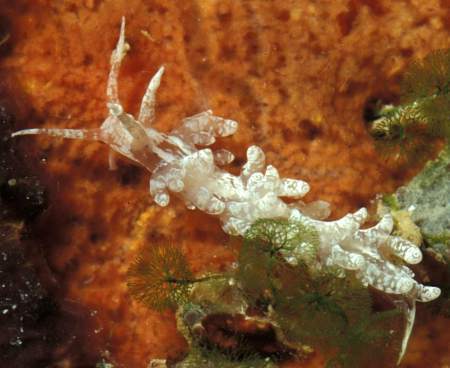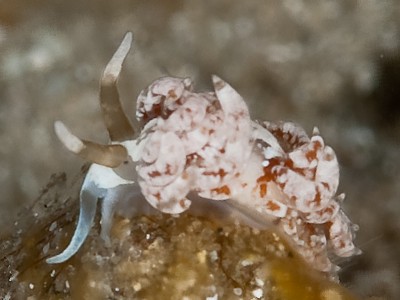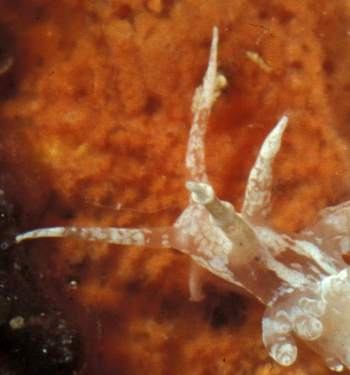
Favorinus auritulus
Marcus, 1955
Order: NUDIBRANCHIA
Suborder: AEOLIDINA
Family: Glaucidae
DISTRIBUTION
Caribbean, south to Brazil
PHOTO
Belize. Photo: Jeff Hamann.
Body translucent clear with scattered white patching all over body and cerata. Bottom half to two thirds of rhinophores is sometimes brown. Rhinophores usually have 3 swellings on the rhinophores but the number ranges from one to three, apparently dependent on the animal's length. It was previously considered that both Favorinus auritulus and the European Favorinus branchialis co-occurred in the Caribbean and could be separated by the number of rhinophore swellings - 2 in F. branchialis and 3 in F. auritulus but Edmunds & Marcus (1977) concluded that F. auritulus was the sole Favorinus in the tropical west Atlantic. A similar species, F. ghanensis Edmunds, 1968, from west Africa, is also reported to have the lower two-thirds of the rhinophores coloured brown.
Favorinus auritulus, like all species of the genus, feeds on opisthobranch eggs, and the colour of the eggs can chnage the colour of the ceratal digestive gland. Redfern (2001) also reports a specimen feeding on the arborescent bryozoan Zoobotryon verticillatum.
References:
• Edmunds, M. (1964) Eolid mollusca from Jamaica, with descriptions of two new genera and three new species. Bulletin of Marine Science of the Gulf and Caribbean, 14(1): 1-32.
• Edmunds, M. & Just, H. (1983) Eolid nudibranchiate Mollusca from Barbados. Journal of Molluscan Studies, 49(3): 185-203.
• Edmunds, M. & Marcus, Ev (1977) On Favorinus auritulus Marcus and Favorinus branchialis (Mueller). Journal of Molluscan Studies, 43(2): 200-201.
• Marcus, Er. (1955) Opisthobranchia from Brazil. Boletim da Faculdade de Filosofia, Ciencias e Letras. Universidade de Sao Paulo, Zoologia 20: 89-261. (Pls. 1-30)
• Marcus, Ev. & Hughes, H.P.I. (1974) Opisthobranch mollusks from Barbados. Bull. Mar. Sci., 24(3): 498-532.
• Marcus, Ev. & Marcus, Er. (1963) Opisthobranchs from the Lesser Antilles. Studies on the Fauna of Curacao and other Caribbean Islands, 19(79): 1-76.
• Marcus, Ev. (1977) An annotated checklist of the western Atlantic warm water opisthobranchs. Journal of Molluscan Studies, (Suppl. 4), 1-23.
• Redfern, C. 2001 Bahamian Seashells: a Thousand Species from Abaco, Bahamas
• Thompson, T.E. (1980) Jamaican opisthobranch molluscs: II Journal of Molluscan Studies, 46(1): 74-99.
Rudman, W.B., 2002 (September 25) Favorinus auritulus Marcus, 1955. [In] Sea Slug Forum. Australian Museum, Sydney. Available from http://www.seaslugforum.net/find/favoauri
Related messages
Re: Favorinus auritulus from Florida
June 2, 2010
From: Linda Ianniello

Concerning message #22476:
Hi, Dr. Bill, just to add some confusion re the bumps on the rhinophores, here is an example with at best a very faint bump on one rhinophore!
Locality: Lake Worth Lagoon, 15 feet, Florida, USA, Intracoastal waterway, Atlantic, 12 May 2010, Rubble. Length: Small!. Photographer: Linda Ianniello.
Best wishes,
Linda
lindai1@bellsouth.net
Ianniello, L.M., 2010 (Jun 2) Re: Favorinus auritulus from Florida. [Message in] Sea Slug Forum. Australian Museum, Sydney. Available from http://www.seaslugforum.net/find/23674Dear Linda,
Thanks for your addition to the confusion. 20 years ago the number of bumps were considered an important species character but it seems they should be used with caution. Apart from anything else it seems that if a rhinophore is damaged or bitten off the replacement may grow back without bumps!
Best wishes,
Bill Rudman
Favorinus auritulus from Florida
May 26, 2009
From: Linda Ianniello


Concerning message #8060:
Dr. Bill, here is a recent find that I believe is a Favorinus auritulus, even though it doesn't look like the existing ones on the forum.
Locality: Lake Worth Lagoon, 20 feed, Florida, USA, Atlantic Ocean, 10 May 2009, Tidal. Length: less than .5 inch. Photographer: Linda Ianniello.
Linda Ianniello
lindai1@bellsouth.net
Ianniello, L.M., 2009 (May 26) Favorinus auritulus from Florida. [Message in] Sea Slug Forum. Australian Museum, Sydney. Available from http://www.seaslugforum.net/find/22476
Dear Linda,
Thanks for these nice photos of 'typical' F. auritulus. This form with the btoom part of the rhinophores being brown and with one or two swellings certainly shows its similarity to the European F. branchialis and the west African F. ghanensis. As I note on the F. ghanensis Fact Sheet the relationship between these three species is still unresolved. Interestingly your animal has one completely brown rhinophore with a single swelling and a second rhinophore with two swellings, one white the other brown. In some discussions, the number of rhinophoral swellings has been considered an important character in defining species. Your photo suggests such ideas need to be treated with caution.
Best wishes,
Bill Rudman
Re: Caribbean Favorinus
October 2, 2002
From: Jun Imamoto
Dear Bill,
Thank you for the comment about aeolid rhinophores. I had wondered about the importance of the the number of 'swellings'. I agree that is useful to observe many individuals. Your comments were very interesting.
Thank you very much.
Best Regards,
Jun Imamoto
http://umiushi.zive.net/
imamoto@wips.co.jp
Imamoto, J., 2002 (Oct 2) Re: Caribbean Favorinus. [Message in] Sea Slug Forum. Australian Museum, Sydney. Available from http://www.seaslugforum.net/find/8085Re: Caribbean Favorinus
September 29, 2002
From: Jun Imamoto
Dear Dave and Bill,
I have a question about the Caribbean Favorinus. It seems that the form of the rhinophore of this individual isn't symmetrical. Is it common that the rhinophore of the right and the left is different? I think that the form of the rhinophore is important in the description of sea slugs?
Best Regards,
Jun Imamoto
http://umiushi.zive.net/
imamoto@wips.co.jp
Imamoto, J., 2002 (Sep 29) Re: Caribbean Favorinus. [Message in] Sea Slug Forum. Australian Museum, Sydney. Available from http://www.seaslugforum.net/find/8079Dear Jun,
The shape of the rhinophores is important in characterising species of aeolid - that is why I was not certain of Anne DuPont's recent photos of Dondice occidentalis until I could see the shape clearly. Normally the rhinophores are identical in shape, so I suspect in this Favorinus that the right rhinophore has been damaged and has regrown. The number of 'swellings' on the rhinophore has been used to distinguish species of Favorinus, but as I discuss on the Fact Sheet, in this species it seems the number of 'swellings' is related to the size of the animal.
Best wishes,
Bill Rudman
Caribbean Favorinus
September 28, 2002
From: Dave Behrens


Dear Bill:
I notice that a number of competent Branchers knowledgeable about Caribbean species are now participating on the Forum. Maybe one of them can assist with naming this beast. I have not been able to put a name on it. It was collected at an offshore cay in Belize. The photograph was taken by Jeff Hamann.
Thanks
Dave Behrens
dave@seachallengers.com
Behrens, D., 2002 (Sep 28) Caribbean Favorinus. [Message in] Sea Slug Forum. Australian Museum, Sydney. Available from http://www.seaslugforum.net/find/8060Dear Dave,
I would suspect that this is a form of Favorinus auritulus. Although Marcus, Edmunds and Thompson, mention the brown on the lower half of the rhnophores, Colin Redfern, who has seen many specimens, notes that often they don't have any brown on the rhinophores. See my comments on the species Fact Sheet.
Best wishes,
Bill Rudman
